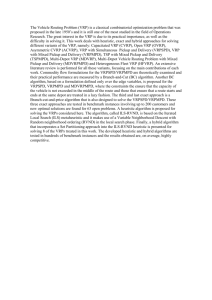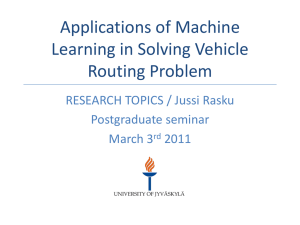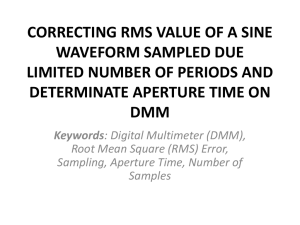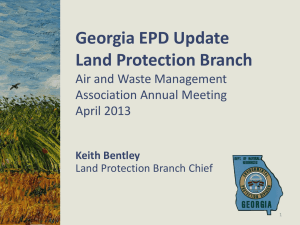Min-Max vs. Min-Sum Vehicle Routing: A Worst
advertisement
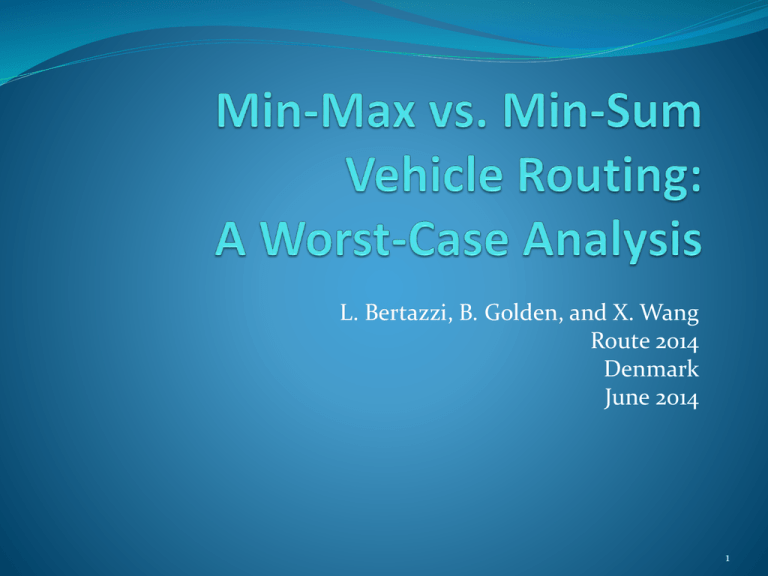
L. Bertazzi, B. Golden, and X. Wang Route 2014 Denmark June 2014 1 Introduction In the min-sum VRP, the objective is to minimize the total cost incurred over all the routes In the min-max VRP, the objective is to minimize the maximum cost incurred by any one of the routes Suppose we have computer code that solves the min-sum VRP, how poorly can it do on the min-max VRP? Suppose we have computer code that solves the min-max VRP, how poorly can it do on the min-sum VRP? 2 Introduction Applications of the min-max objective Disaster relief efforts Serve all victims as soon as possible Computer networks Minimize maximum latency between a server and a client Workload balance Balance amount of work among drivers and/or across a time horizon 3 An Instance of the VRP The min-max solution The min-sum solution Max load = 2 Max # vehicles = 2 total cost 6 2 5 10 .47 min-max cost 3 5 5.24 total cost 6 3 2 10 .24 min-max cost 4 2 2 6.83 4 Motivation behind our Worst-Case Study Observation: The min-max solution has a slightly higher (2.2%) total cost, but it has a much smaller (23.3%) min-max cost Also, the routes are better balanced Is this always the case? What is the worst-case ratio of the cost of the longest route in the min-sum VRP to the cost of the longest route in the min-max VRP? What is the worst-case ratio of the total cost of the min-max VRP to the total cost of the min-sum VRP? 5 Variants of the VRP Studied Capacitated VRP with infinitely many vehicles (CVRP_INF) Capacitated VRP with a finite number of vehicles (CVRP_k) Multiple TSP (MTSP_k) Service time VRP with a finite number of vehicles (SVRP_k) 6 CVRP_INF Capacitated VRP with an infinite number of vehicles rMM : the cost of the longest route of the optimal min-max solution MS r : the cost of the longest route of the optimal min-sum solution z MM : z the total cost of the optimal min-max solution : the total cost of the optimal min-sum solution MS The superscript denotes the variant 7 A Preview of Things to Come For each variant, we present worst-case bounds In addition, we show instances that demonstrate that the worst-case bounds are tight 8 CVRP_INF MS r MM r # customers: n =1+1/ε capacity = 1/ε rMM 2 MS r 2 n 21 1 9 CVRP_INF z MM z MS # customers: n =1+1/ε capacity = 1/ε z MM 21 1 zMS 4 n 2 5 10 CVRP_k Capacitated VRP with at most k vehicles available k k k k rMS zMS zMM krMM k k rMS rMM k k k k k zMM krMM krMS kzMS k k z MM z MS k 11 CVRP_k k k k rMS rMM k rMM 2 2 rMS 2k k 1 k 12 CVRP_k k k zMM zMS k k zMM 2k k zMS 2 k 1 13 MTSP_k Multiple TSP with k vehicles The customers just have to be visited Exactly k routes have to be defined M M M M M M r rMM k r z z kr MS MS MS MM MM M M M M M M zMM krMM krMS kzMS zMM zMS k 14 MTSP_k M rMM 2 M M rMS rMM k rMS 2 k 12 M 2k k 1 15 MTSP_k M zMM 2k M M zMM zMS k M zMS 2 2k 1 k 1 2 3 k 1 16 SVRP_k Service time VRP with at most k vehicles Customer demands are given in terms of service times Cost of a route = travel time + service time Routing of the min-sum solution is not affected by service times Routing of the min-max solution may be affected by service times r S z S z S kr S r S r S k MS MS MM MM MS MM 17 SVRP_k Min-max solution without service times Min-max solution with service times 18 SVRP_k S S rMS rMM k S rMM 2 2t 2 S rMS 2k 2kt k 1 19 SVRP _k S S S S S S z kr kr kz z z The bound MM MM MS MS MM MS k is still valid, but no longer tight We prove the tight bound S S zMM kzMS k 1T, where T = total service time in our paper 20 SVRP_k S zMM kzMS k 1T S z MM 2k T S zMS 2 k 1 T S 21 A Summary Ratio of the cost of the longest route CVRP_INF CVRP_k MTSP_k SVRP_k MS r MM r Ratio of the total cost z MM z MS k k M M zMM zMS k S S zMM kzMS k 1T zMS zMM k rMS rMM k rMS rMM k k k M M zMM zMS k S S 22 Conclusions If your true objective is min-max, don’t use the min- sum solution If your true objective is min-sum, don’t use the min- max solution 23
